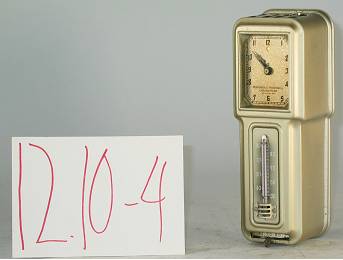Pressure Atomizing Oil Burner Equipment and Systems – Room Temperature Thermostats
The “Chronotherm” room thermostat with “Telechron”, synchronous, electric motor driven automatic night set-back, helical bimetal temperature sensor, low voltage, snap action, open contact switching, and mercury glass stem thermometer, would prove to be iconic in its times, a precursor of much to come in layered, multi-functional, consumer technology for the Canadian home, Type T12, Minneapolis-Honeywell Regulator Co, Minneapolis, Minn., Circa 1934.
Technical Significance:
* The T12 makes use of Series 10, three-wire thermostat circuitry with heat anticipator, bringing the heating system on sooner than otherwise, in order to reduce the thermal lag in the heating system.
* The introduction of the automatic, time/temperature actuated control systems for home heating was as much a marker of profound technologic change as it was socio-cultural change [see below]. They introduced layered, multi-functional, consumer technology to the Canadian home [devices that would perform more than one function].
* Such devices were iconic in their impact and consequences for Canadians, beginning to suggest the power of technology and its potential for shaping and constantly re-shaping the life of Canadians throughout the balance of the 20th century.
* With the introduction of automatic night set-back thermostats in the late 1920’s through early 30’s, by both Time-O-Stat and Honeywell, the automation of the Canadian household was ratchet up one more notch, It would seem, at the time, that the automation of home heating comfort, by the HVACR industry, had gone as far as it was likely to go. Such, however was not the case, however, with a myriad of new consumer devices to follow, with for example automatic: heat anticipation [See ID 220], humidity control [See ID 222], air filtration [See series 15.06, early air filtration technology, area temperature zone control and integrated heating/cooling controllers [See ID 217].
Industrial Significance:
* Earlier versions of the technology, using an 8-day wind-up clock, are shown in Time-O-Stat’s product catalogue with patent numbers sited back to 1928.
* The development of the miniature, self starting, synchronous, alternating current motor technology by Telechron, and the mass production of motors for electric clocks and timing devices, was in itself an significant scientific, engineering and manufacturing accomplishment for the period – with applications and benefits which would be far reaching.
* Following the introduction of small synchronous type motors for electric clocks in the early 1930’s Minneapolis-Honeywell introduced their “Chronotherm”, a basic technology that would appear in various forms through to the introduction of digital control technology in the 1990’s.


